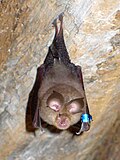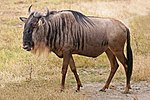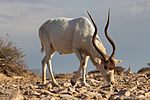variation in the mammalian gestation period. Journal of Mammalogy, 63(4), 646-652. Larry Vogelnest; Rupert Woods (August 18, 2008). Medicine of Australian Mammals...
30 KB (998 words) - 14:20, 16 August 2024
Estrous cycle (category Mammalian sexuality)
(oîstros) 'gadfly') is a set of recurring physiological changes induced by reproductive hormones in females of mammalian subclass Theria. Estrous cycles...
28 KB (3,425 words) - 21:47, 13 August 2024
Meerkat (redirect from Meerkat gestation)
around the year, with peaks during heavy rainfall; after a gestation of 60 to 70 days, a litter of three to seven pups is born. They live in rock crevices...
55 KB (6,416 words) - 09:53, 17 August 2024
Ocelot (redirect from Hunting behavior of ocelots)
at around two years of age and can breed throughout the year; peak mating season varies geographically. After a gestation period of two to three months...
64 KB (6,832 words) - 06:10, 5 August 2024
Uterus (redirect from Fundus of uterus)
also applied to analogous structures in some non-mammalian animals. In the human, the lower end of the uterus is a narrow part known as the isthmus that...
32 KB (3,309 words) - 17:39, 20 August 2024
Animal sexual behaviour (redirect from Mammalian sexual behavior)
oestrus (the most fertile period in the mammalian female's reproductive cycle), which increases the chances of successful impregnation. Some animal sexual...
128 KB (13,898 words) - 21:28, 3 July 2024
(86–95 °F) body temperature decreases to 2–5 °C (36–41 °F). Hedgehog gestation lasts 35–58 days, depending on species. The average litter is 3–4 newborns...
31 KB (3,102 words) - 01:36, 29 July 2024
Cortisol (category CS1 maint: DOI inactive as of January 2024)
cortisol is mostly of maternal origin during the first 122 days, 88% or more is of fetal origin by day 136 of gestation. Although the timing of fetal cortisol...
78 KB (8,594 words) - 12:55, 16 August 2024
Horseshoe bat (redirect from List of Rhinolophus species)
but at least one species is monogamous, while another is polygynous. Gestation is approximately seven weeks and one offspring is produced at a time....
56 KB (5,930 words) - 02:35, 17 August 2024
Western spotted skunk (category IUCN Red List least concern species)
around April. Including this period of delayed implantation, gestation lasts 230 to 250 days, with the litter of two to five young being born in May....
14 KB (1,741 words) - 19:58, 7 July 2024
availability of resources in their native habitats. The young are born altricial (eyes and ears closed, no fur) after a gestation period of between 25 and...
46 KB (4,247 words) - 12:48, 26 June 2024
Genet (animal) (category Mammals of Africa)
Common genet females become sexually mature at the age of two years. After copulation, the gestation period lasts for 10 to 11 weeks. They are diestrous...
34 KB (3,409 words) - 13:50, 21 July 2024
Corticotropin-releasing hormone (category Hormones of the hypothalamus)
the length of gestation and the timing of parturition and delivery. A rapid increase in circulating levels of CRH occurs at the onset of parturition...
26 KB (2,919 words) - 11:37, 27 March 2024
Kit fox (redirect from Mating behavior of kit foxes)
October and November, and they mate from December to January-February. Gestation lasts probably around 49–56 days, and the litters are born in February...
17 KB (1,957 words) - 02:10, 25 June 2024
Wildebeest (redirect from Cultural depictions of wildebeests)
contest calls, though both types of calls had similar patterns, amplitudes, and durations. The alarm calls were a response of the baboons to lions, and the...
46 KB (5,495 words) - 08:06, 13 August 2024
Jaguarundi (category IUCN Red List least concern species)
year across the range. After a gestation period of 70 to 75 days, a litter of one to four kittens is born. Lifespans of up to 15 years have been recorded...
43 KB (4,560 words) - 01:12, 25 July 2024
Capybara (redirect from Social behavior of capybaras)
The lifespan of the capybara's sperm is longer than that of other rodents. Capybara gestation is 130–150 days, and produces a litter of four young on...
35 KB (3,629 words) - 06:30, 2 August 2024
Ruffed lemur (redirect from Sexual behavior of ruffed lemurs)
largest of the extant species in Lemuridae, yet exhibit reproductive traits more common in small, nocturnal lemurs, such as short gestation periods (~102...
69 KB (7,620 words) - 19:44, 17 August 2024
Rabbit (redirect from List of rabbit diseases)
seconds. The rabbit gestation period is short and ranges from 28 to 36 days with an average period of 31 days. A longer gestation period will generally...
81 KB (8,723 words) - 08:09, 5 August 2024
Greater bulldog bat (category IUCN Red List least concern species)
young is born each gestation. Male bats mostly breed autumn and winter. Young bats stay in the roosts for one month and are then capable of flight. Both the...
12 KB (1,515 words) - 16:05, 12 August 2024
Cape fox (category IUCN Red List least concern species)
does body slamming. The female Cape fox has a gestation period of 51 to 53 days and gives birth to a litter of one to six cubs (or kits). They typically weigh...
14 KB (1,827 words) - 15:26, 13 February 2024
Mercury poisoning (redirect from Toxic effect of mercury and its compounds)
determined by the peak value of mercury, not the length of the exposure. Methylmercury exposure during rodent gestation, a developmental period that approximately...
84 KB (8,833 words) - 01:21, 9 August 2024
usually of the species Mus musculus. They are the most commonly used mammalian research model and are used for research in genetics, physiology, psychology...
61 KB (6,008 words) - 05:24, 19 July 2024
Pteropus (category CS1 maint: multiple names: authors list)
climates. Flying fox gestation length varies among species; gestation length is 140–190 days (4.6–6.3 months). Females have a litter size of one young at a...
98 KB (10,346 words) - 00:23, 9 August 2024
Eastern meadow vole (category IUCN Red List least concern species)
the two- to four-hour period before sunset. Most of the inactive period is spent in the nest. Gestation lasts 20 to 23 days. Neonates are pink and hairless...
30 KB (3,585 words) - 16:36, 16 June 2024
Arctic fox (redirect from Sexual behavior of arctic foxes)
pups every year. Breeding usually takes place in April and May, and the gestation period is about 52 days. Litters may contain as many as 25 (the largest...
48 KB (5,485 words) - 19:08, 13 June 2024
Addax (redirect from Reproductive behavior of addax antelope)
Anovulation was rare in winter, which suggested the effect of seasons on the estrous cycle. Gestation period lasts 257–270 days (about nine months). Females...
26 KB (3,118 words) - 17:59, 16 August 2024
Lesser mouse-tailed bat (category IUCN Red List least concern species)
cycle per year. The mating season is generally in the months of February to April. Gestation lasts from 95 to 100 days and only one offspring is produced...
10 KB (1,131 words) - 23:19, 3 October 2023
Cheetah (redirect from Sexual behavior of cheetahs)
It breeds throughout the year. After a gestation of nearly three months, females give birth to a litter of three or four cubs. Cheetah cubs are highly...
187 KB (19,269 words) - 20:39, 17 August 2024




























